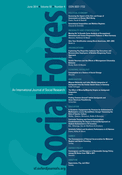-
Views
-
Cite
Cite
Ariela Schachter, Finding Common Ground? Indian Immigrants and Asian American Panethnicity, Social Forces, Volume 92, Issue 4, June 2014, Pages 1487–1512, https://doi.org/10.1093/sf/sou019
Close - Share Icon Share
Abstract
The common political usage of the term Asian American includes Indians, but historical, religious, and phenotypic differences among Indians and East and Southeast Asians raise the question of how far the boundaries of Asian American identity extend. Using the National Asian American Survey, I examine whether the forces that propel Indian immigrants toward selecting a panethnic identification are similar to those of other Asian subgroups. I find that for Indian immigrants who live among large non-Indian Asian populations—the setting most likely to encourage panethnicity for other Asians—both immigrant integration and discrimination serve to discourage a panethnic Asian identification. My findings suggest that the boundaries of Asian American identity are not open for many Indian immigrants, and highlight the importance of group relations for understanding panethnic identification.



